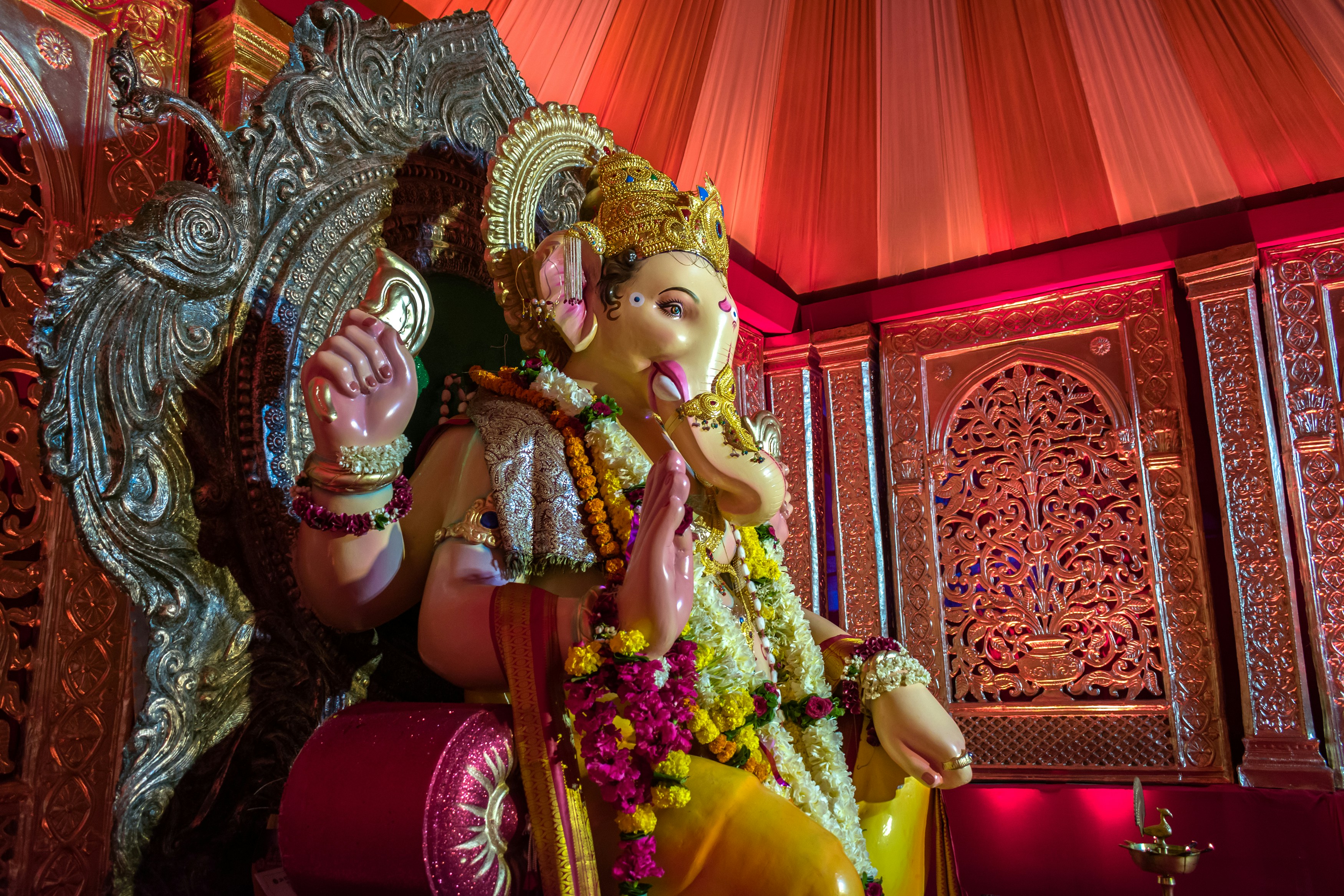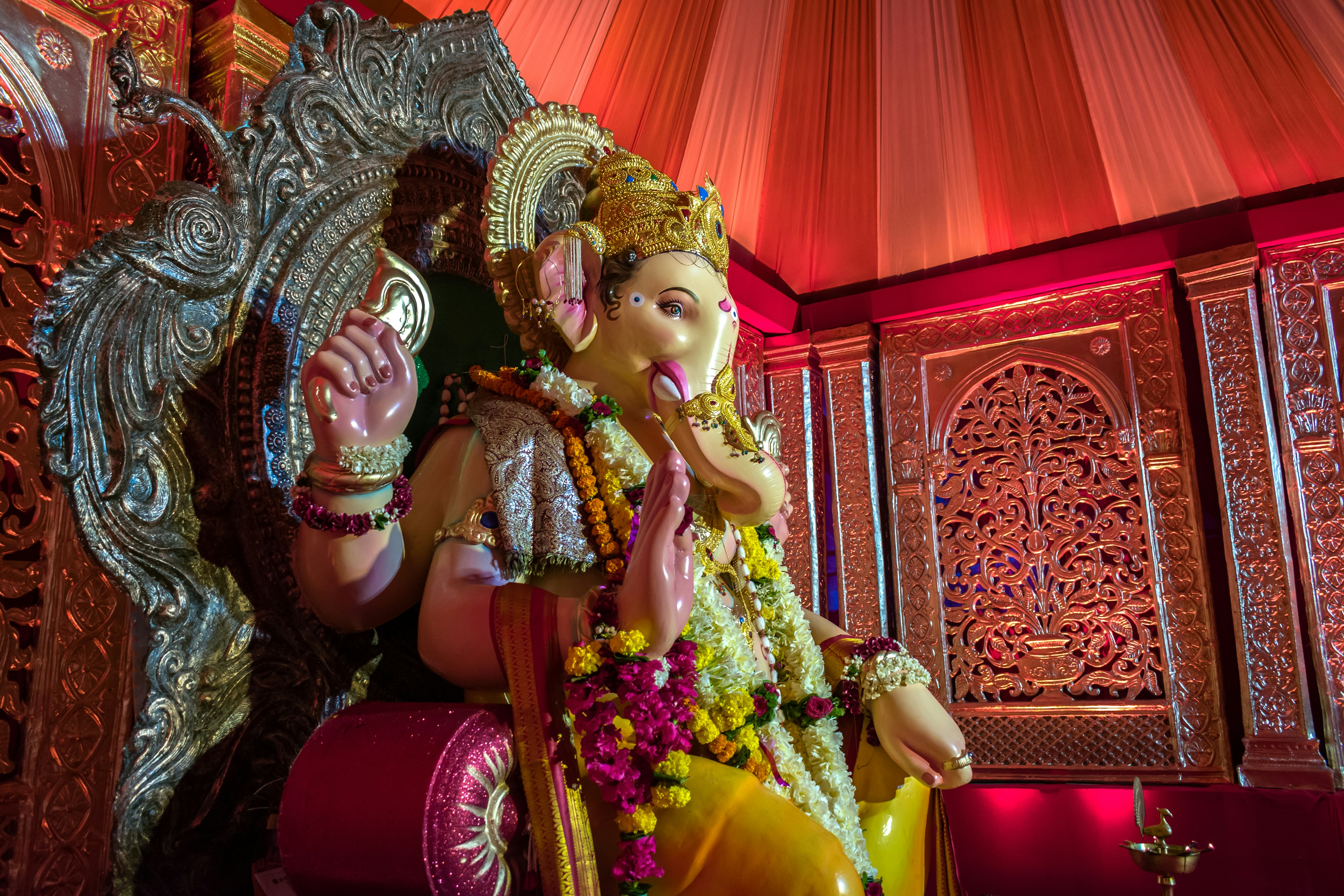Legend has it that the Vishnupad Temple is built on the exact spot where Lord Vishnu himself left his footprint on Earth. This sacred footprint, known as the “Vishnupad,” is believed to be a symbol of Lord Vishnu’s presence and divine power. Pilgrims from far and wide travel to Gaya to pay their respects and seek blessings at this holy site.
The temple itself is a magnificent structure, adorned with intricate carvings and sculptures that depict various scenes from Hindu mythology. The main sanctum houses a 40 cm long footprint, which is believed to be the actual imprint of Lord Vishnu. Devotees offer prayers and perform rituals, seeking divine intervention for their wishes and desires.
Surrounded by lush greenery and nestled on the banks of the sacred Phalgu River, the Vishnupad Temple provides a serene and tranquil atmosphere for spiritual seekers. The sound of the flowing river and the fragrance of incense fill the air, creating an ambiance of devotion and piety.
Visitors to the temple can also explore the nearby Brahma Kund, a sacred pond believed to have been created by Lord Brahma himself. It is said that taking a dip in the holy waters of Brahma Kund can cleanse one’s sins and bestow spiritual purification.
Aside from its religious significance, the Vishnupad Temple also holds historical importance. It is said to have been constructed by Queen Ahilyabai Holkar of Indore in the 18th century. Over the years, the temple has undergone several renovations and expansions, yet it has managed to retain its architectural grandeur and spiritual allure.
Gaya itself is a city steeped in history and mythology. It is believed to be the place where Lord Buddha attained enlightenment under the Bodhi Tree. The city is also home to several other important religious sites, such as the Mahabodhi Temple and the Tibetan Monastery.
For those seeking a deeper connection with their spiritual selves, a visit to the Vishnupad Temple in Gaya is a must. It offers a unique opportunity to experience the divine presence and immerse oneself in the rich cultural and religious heritage of Bihar.
The Vishnupad Temple, located in the city of Gaya in the Indian state of Bihar, holds immense significance in Hindu mythology and is considered one of the holiest pilgrimage destinations in the country. The temple is dedicated to Lord Vishnu, the preserver and protector of the universe, and is believed to be the spot where he placed his foot, leaving a divine footprint on a solid rock.
Legend has it that during a battle between Lord Vishnu and the demon Gayasur, the demon was defeated and sought redemption. Lord Vishnu granted him a boon, allowing him to become a part of the holy land of Gaya. As a result, the city of Gaya is believed to be a place where one can attain salvation and liberation from the cycle of birth and death.
The sacred footprint, known as the Vishnupad, is the main attraction of the temple and is considered to be a symbol of Lord Vishnu’s presence and blessings. Devotees flock to the temple from all corners of the country and even abroad to seek the divine blessings of Lord Vishnu and offer their prayers.
The temple complex is a sprawling structure with intricate carvings and architectural brilliance. The main sanctum houses the sacred footprint, which is adorned with flowers and offered various offerings by the devotees. The atmosphere inside the temple is filled with devotion and spirituality, as devotees chant hymns and offer their prayers to Lord Vishnu.
One of the most significant times to visit the Vishnupad Temple is during the Pitru Paksha period. Pitru Paksha, also known as the fortnight of ancestors, is a 16-day period in the Hindu calendar dedicated to honoring one’s ancestors. It is believed that during this time, the souls of departed ancestors visit the earth and bless their descendants. Devotees perform various rituals and offer food and water to their ancestors to seek their blessings and ensure their well-being in the afterlife.
During the Pitru Paksha period, the Vishnupad Temple attracts a large number of devotees who come to pay their respects to their ancestors and seek their blessings. The temple premises are filled with devotees performing rituals and offering prayers, creating a spiritually charged atmosphere.
Aside from its religious significance, the Vishnupad Temple also holds historical and architectural importance. The temple complex is a fine example of ancient Indian architecture, with its intricate carvings and detailed sculptures. It stands as a testament to the rich cultural heritage of the region and attracts not only religious pilgrims but also history enthusiasts and art lovers.
Visiting the Vishnupad Temple is not just a religious journey but also a cultural and historical experience. The temple’s serene surroundings, the divine presence of Lord Vishnu, and the spiritual energy that fills the air make it a must-visit destination for anyone seeking solace, enlightenment, and a deeper connection with the divine.
The architecture and design of the Vishnupad Temple is a testament to the rich cultural heritage and artistic prowess of the ancient craftsmen. The Nagara style of architecture, prominent in North India, is characterized by its towering spires and intricate carvings. The tall and curvilinear spires of the temple draw the eyes upwards, creating a sense of awe and reverence.
As you step into the temple complex, you will be greeted by a sprawling courtyard that exudes a sense of serenity and tranquility. The courtyard is adorned with smaller shrines dedicated to various deities, each with its own unique architectural features and intricately carved sculptures. These smaller shrines serve as a testament to the inclusivity and diversity of Hinduism, where different deities are worshiped and revered.
The main sanctum of the Vishnupad Temple is the focal point of the complex. It is here that the sacred footprint of Lord Vishnu is enshrined. The sanctum is a visual delight, with its walls adorned with exquisite carvings depicting gods, goddesses, and scenes from Hindu mythology. Every inch of the sanctum is a work of art, showcasing the skill and dedication of the craftsmen who painstakingly carved these intricate designs.
One of the highlights of the temple is the sacred pond known as the Brahma Kund. This holy pond is believed to have divine powers and is considered a sacred spot for devotees. Before entering the main temple, devotees take a dip in the Brahma Kund, cleansing their bodies and purifying their souls. The act of bathing in the holy waters of the Kund is seen as a way to wash away sins and seek spiritual rejuvenation.
Overall, the architecture and design of the Vishnupad Temple is a true marvel, showcasing the artistic brilliance and devotion of the people who built it. The intricate carvings, the towering spires, and the sacred pond all come together to create a spiritual haven that leaves visitors in awe of its beauty and grandeur.
Religious Significance
The Vishnupad Temple holds immense religious significance for Hindus. It is believed that performing rituals and offering prayers at the temple can bring peace, prosperity, and salvation to the devotees. Many people also come to the temple to perform the last rites for their departed loved ones, as it is believed to ensure their liberation.
According to Hindu mythology, Lord Rama, the seventh avatar of Lord Vishnu, performed the pind daan ritual at the Vishnupad Temple to seek salvation for his father, King Dasharatha. This further adds to the temple’s significance as a place of ancestral worship and remembrance.
In addition to its association with Lord Rama, the temple is also linked to several other Hindu deities. The main deity of the temple is Lord Vishnu, who is believed to be the preserver and protector of the universe. Devotees offer prayers and seek blessings from Lord Vishnu for various reasons, such as good health, success in endeavors, and fulfillment of desires.
Another deity worshipped at the Vishnupad Temple is Lord Shiva, who is considered the destroyer and transformer in Hindu mythology. Lord Shiva is believed to reside in the temple in the form of a lingam, a symbolic representation of his divine energy. Devotees offer prayers to Lord Shiva for inner peace, spiritual enlightenment, and liberation from worldly attachments.
Furthermore, the temple is also associated with Goddess Lakshmi, the goddess of wealth and prosperity. Devotees seek the blessings of Goddess Lakshmi for financial abundance, material well-being, and overall prosperity in life.
Due to its religious significance and association with multiple deities, the Vishnupad Temple attracts devotees from all over the country and even from abroad. Pilgrims visit the temple throughout the year, especially during festivals and auspicious occasions, to seek divine blessings and spiritual solace.
In addition to these religious sites, Gaya also offers a range of cultural and historical attractions. One such place is the Gaya Museum, which houses a vast collection of archaeological artifacts, sculptures, and paintings that provide insights into the rich history and heritage of the region.
If you are interested in exploring the natural beauty of Gaya, a visit to the Brahmayoni Hill is highly recommended. This picturesque hill offers panoramic views of the surrounding landscape and is a popular spot for nature lovers and photographers.
Gaya is also known for its vibrant markets and bustling bazaars. The Vishnupad Temple area is dotted with shops selling religious items, souvenirs, and local handicrafts. Exploring these markets is a great way to experience the local culture and pick up some unique mementos.
For those seeking a moment of tranquility and serenity, a boat ride on the Falgu River is a must-do activity. The river flows through Gaya and offers a peaceful escape from the hustle and bustle of the city. It is also believed to have mythological significance and is considered sacred by Hindus.
Lastly, Gaya is known for its vibrant festivals and celebrations. The most popular festival in the city is the Pitrapaksha Mela, which takes place in September. During this festival, thousands of devotees gather in Gaya to pay homage to their ancestors and perform rituals for their salvation.
With its rich cultural heritage, historical significance, and natural beauty, Gaya offers a diverse range of attractions for visitors to explore and enjoy. Whether you are a history buff, a nature lover, or a spiritual seeker, Gaya has something to offer to everyone.
Enter your email to get the Latest Updated Exploring News and Topics
Discover more from atozexplore.com
Subscribe to get the latest posts sent to your email.







